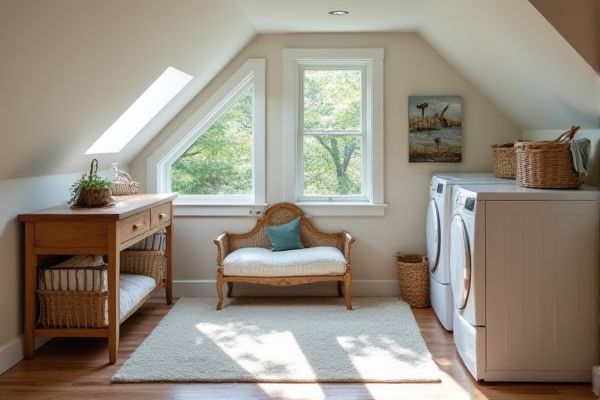
An attic pet nook offers a cozy, quiet retreat with personalized climate control, ideal for pets needing solitude, while a laundry room pet bed provides easy access to household activity and warmth from appliances. Discover which option suits Your pet's comfort and lifestyle by reading the rest of the article.
Table of Comparison
| Feature | Attic Pet Nook | Laundry Room Pet Bed |
|---|---|---|
| Location | Secluded, quiet attic space | Functional, accessible laundry room |
| Temperature Control | Often warmer but may lack ventilation | Variable temperature, usually cooler |
| Noise Level | Low ambient noise, peaceful | Moderate noise from appliances |
| Accessibility | Requires stairs or ladder access | Easily accessible on main floor |
| Space | Compact, cozy for small pets | Typically larger with more floor space |
| Safety Concerns | Potential for drafts, insulation issues | Risk from laundry chemicals and machines |
| Cleaning | Less frequent, may be harder to reach | Regular cleaning needed due to dust and lint |
| Ideal For | Pets preferring quiet, warm environments | Pets comfortable around household activity |
Attic Pet Nook vs. Laundry Room Pet Bed: Overview
An attic pet nook offers a quiet, elevated space that provides warmth and seclusion, ideal for pets needing a calm retreat, while a laundry room pet bed benefits from easy access to household activity and consistent temperature control due to appliances. Attic spaces often feature better insulation and reduced noise compared to laundry rooms, making them suitable for pets sensitive to disturbances. Laundry room pet beds offer convenience for pet owners, with proximity to cleaning supplies and water sources, but may expose pets to occasional noise and moisture.
Space Utilization: Pros and Cons
An attic pet nook offers excellent space utilization by converting often underused areas into cozy retreats, maximizing vertical storage while keeping pets comfortable away from household traffic. In contrast, a laundry room pet bed benefits from proximity to regular activity, ensuring your pet stays close, but may suffer from noise and limited floor space that can reduce comfort. Your choice depends on balancing quiet seclusion with convenience, factoring in available square footage and the pet's need for interaction or solitude.
Comfort and Safety Considerations
Attic pet nooks often offer a quiet, insulated environment that can keep Your pet warm and safe from household noise, making them ideal for rest. Laundry room pet beds provide easy access to fresh air and supervision but may expose pets to hazards like detergents or loud appliances. Prioritizing soft bedding and secure placement ensures comfort and safety in either location, tailored to Your pet's needs.
Temperature and Ventilation Differences
An attic pet nook often experiences higher temperatures and limited ventilation, which can lead to discomfort for your pet during warmer months. In contrast, a laundry room pet bed typically benefits from better airflow and more consistent temperatures due to household ventilation systems. Choosing the right location ensures your pet stays comfortable and safe, with temperature regulation and fresh air playing key roles.
Accessibility for Your Pet
An attic pet nook offers a quiet, elevated retreat but may pose accessibility challenges for pets with limited mobility due to stairs or narrow entry points. In contrast, a laundry room pet bed is typically more accessible, situated on the ground floor with easy entry and exit for pets of all ages and abilities. Choosing the right location depends on evaluating your pet's mobility and the ease with which they can reach their resting area safely and comfortably.
Noise and Disruption Levels
An attic pet nook offers a quiet retreat with minimal noise and disruption, making it ideal for pets sensitive to household sounds, while a laundry room pet bed may be subject to frequent noise from washers and dryers. The consistent operational sounds in laundry areas can cause stress or anxiety in pets, reducing their comfort and rest quality. Choosing an attic space can provide a more peaceful environment, essential for pet well-being and relaxation.
Cleaning and Maintenance
Attic pet nooks often accumulate more dust and require frequent vacuuming due to limited airflow and insulation materials, making regular cleaning essential to maintain hygiene. Laundry room pet beds benefit from proximity to washing machines, allowing easier access to water and detergent for frequent washing of removable covers and bedding. Both options demand consistent maintenance, but laundry rooms typically offer a more practical setup for thorough cleaning and odor control.
Personalization and Design Potential
An attic pet nook offers exceptional personalization and design potential, allowing you to create a cozy, custom space tailored to your pet's specific preferences and your home's unique architecture. Your pet bed in the attic can incorporate built-in shelves, soft lighting, and personalized decor to maximize comfort and aesthetic appeal. In contrast, a laundry room pet bed often provides a practical, space-efficient solution but typically lacks the same level of design flexibility and intimate customization.
Cost Comparison and Budget Tips
An attic pet nook often requires additional insulation and ventilation, which can increase costs compared to a laundry room pet bed that utilizes existing temperature control and plumbing. Your budget can be optimized by repurposing laundry room space, minimizing renovation expenses, and selecting cost-effective materials for comfort. Choosing budget-friendly options and DIY enhancements can significantly reduce expenses while maintaining a cozy retreat for your pet.
Which Pet Space is Best for Your Home?
Choosing between an attic pet nook and a laundry room pet bed depends on factors like space, temperature, and noise levels specific to your home. An attic pet nook offers a quiet, secluded area with controlled climate, ideal for pets needing a calm retreat. Conversely, a laundry room pet bed provides easy accessibility and a cooler environment but may expose pets to louder sounds and household activity disruptions.
 homyna.com
homyna.com